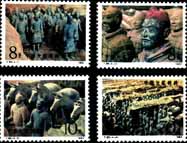The tomb of Emperor Qinshihuang

The tomb of Emperor Qinshihuang
| 
|
The tomb of Emperor Qinshihuang (the First Emperor of Qin Dynasty)
is located five kilometers to the east of the Lintong county,
Shaanxi Province. According to the "Historic Chronicle",
soon after he was crowned, Qinshihuang began to build his tomb
at Lishan. After he conquered the whole nation, the project was
expanded, involving a total of 700,000 people, and lasting about
30 years. But, it remained unfinished by the time the Qin Dynasty
was overthrown.The terra-cotta warriors and horses comprise a
mass of sculptures. They were used as articles buried with the
dead emperor. Totally 3,000 items, large and small, were first
discovered in the Yangjiawan village, 22 kilometers to the east
of Xian'yang city on August 8, 1965. They were put on display
first on July 31, 1981, at the Xian'yang museum.
Design:
The four stamps have captions respectively: "Terra-cotta of a mass troop" for stamp 4-1; "Pottery figurines" for stamp 4-2; "Terra-cotta of warriors and horses" stamp 4-3; and "The pit of the terra-cotta figurings" for stamp 4-4. These terra-cotta figurines are boasted to be the 8th wonder in the world. The terra-cotta warriors and horses are made life-sized, animated and proportional in constitution. The warrior figurines are mostly 1.8 meters tall, the tallest one is 1.97 meters tall. They look sturdy and strong. Even wrapped by armors, their developed muscles can be seen. Their uniforms, decorations, appearances and manners are different, depending on their ranks and experiences. Some are wise and awe-inspiring generals, some are brave and resolute sergeants, and some are naive newly-recruited soldiers.The pottery horses all gape. The mane is neatly divided into two clusters on their front head. They straighten up their ears and appear vigilant.According to experts, the process of making terra-cotta warriors and horses is rather complicated. Firstly, pottery models must be made to resemble every part of their bodies. Secondly, the models are assembled and glued together. Thirdly, details such as eyes, mouth, nose, hair, beard, armor and texture of clothes are engraved. Examining the residues of some terra-cotta figurines, experts believe 23 categories of paints had been used, such as bright red, rosy red, purplish red, pink, orange yellow, and light yellow.
 Homepage Homepage |  Email Email |